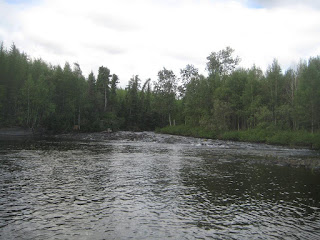Early morning breakfast in camp 34 at 6 am, the rising sun casting shadows of the trees behind camp.
Looking upstream after the 480 metre portage.
I finally pass through an area of mature trees after many kilometres of recently burned forest.
When I reach a gravel road, I stop before these large culverts to check out the other side. There have been winter portages along the river thus far, but now the trails peter out as few if anyone travel them anymore, and obviously no snow machines.
After walking across the road and along the river to verify safety, I canoe through the centre culvert and run the 300 metre rapids, which end in a pool at the head of another set of rapids. I have canoed under bridges before but this is the first time in a culvert. It is eerie because of the hollow-sounding tinny echo but sure beats portaging. My information indicates a portage on the left side of the river, the logical place because the river bends that way farther downstream so a trail there would be shorter than the other side. First I stop to have lunch, then walk through the bush in various places to search for a portage trail. I check close to the river, and farther inland, all the way to where the likely lower end of a portage would be. If there was a trail here I cannot find any sign of it. So I canoe back upstream and across the river to check the other side. There is an old trail, that follows the river, much of it quite steep and all of it obscured with brush and fallen trees, large and small. It extends for at least 800 metres winding its way around a gorge with a big falls. Aie! If I have to clear this trail it will take a long day at least and there is no good campsite. I walk back to the canoe along the river. There is no way to canoe down the falls but I think I might canoe close to the falls where I perhaps could set up a camp, then cut a much shorter trail. I canoe back across and down the river to the other side and check out the left side again thinking to cut a trail on that side. However, no matter where I walk it will be a big job. There are steep banks on both sides of the river, many are vertical rock cliffs.
So I go back across to the right hand side again, and check along the rapids more carefully. I find a small relatively flat and clear place with low banks that will work as a campsite. I decide to run the rapids right to the midway point of this spot, where I must stop because the falls is just downstream about 50 metres. On three separate branches overlooking the river, just upstream from where I have to stop, I tie orange flagging tape so I will recognize where to stop. I doublecheck all the rapids all the way back to the canoe about 300 metres to visualize where I must steer. After all this checking and double-checking I am ready to go, personal flotation device (PFD) on, wading gear on, painter ropes stretched across the top of the load for easy access. The canoe grazes a few boulders, slides off two a bit hard, brushes against two down spruce trees and turns sideways then backwards once. At the orange markers, I get close to shore and thankfully the rapids here are shallow so I hop out of the canoe and drag the canoe to shore to unload. Yeah, I make it!
Camp 35, four km travelled with a 480 metre portage, and running two 300 metre rapids. It is a narrow spot in a gorge between the rapids and a steep vertical rock cliff. Camp is nicely tucked into the beautiful river valley.
August 21, from this point I cut and clear a 270 metre trail, up a steep cliff to connect to the old portage and then to the base of the rapids below the falls. It is a gorgeous cool 10°C morning with no bugs, but as I start to clear the portage I have to don my headnet against the very bothersome blackflies. I then walk downstream to the next rapids which I hope I can run as there does not appear to be a usable portage. I walk along the rapids and determine that it is runnable.
August 21, from this point I cut and clear a 270 metre trail, up a steep cliff to connect to the old portage and then to the base of the rapids below the falls. It is a gorgeous cool 10°C morning with no bugs, but as I start to clear the portage I have to don my headnet against the very bothersome blackflies. I then walk downstream to the next rapids which I hope I can run as there does not appear to be a usable portage. I walk along the rapids and determine that it is runnable.
The forest here has very large mature spruce trees, many with these bare spots around the diameter of the trunk about one metre above the ground. I think the cause is either bugs or infection.
























